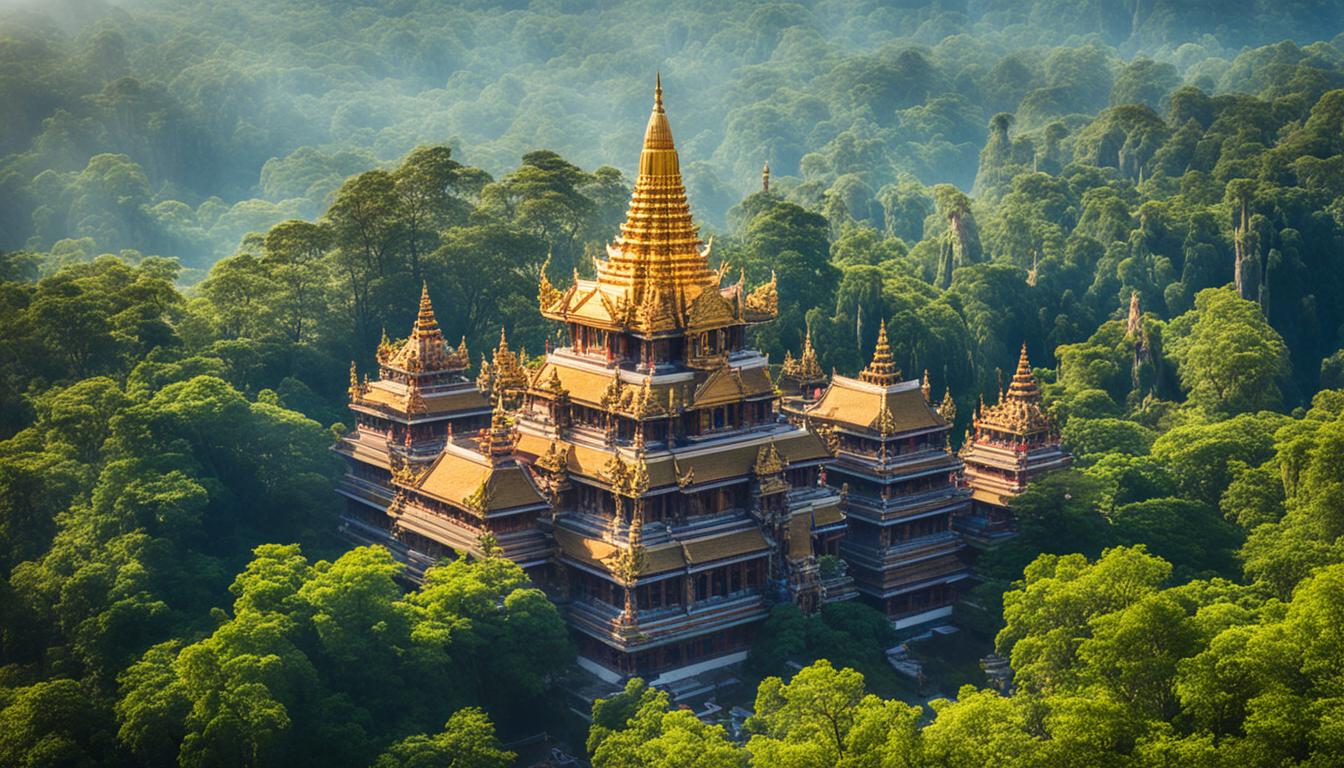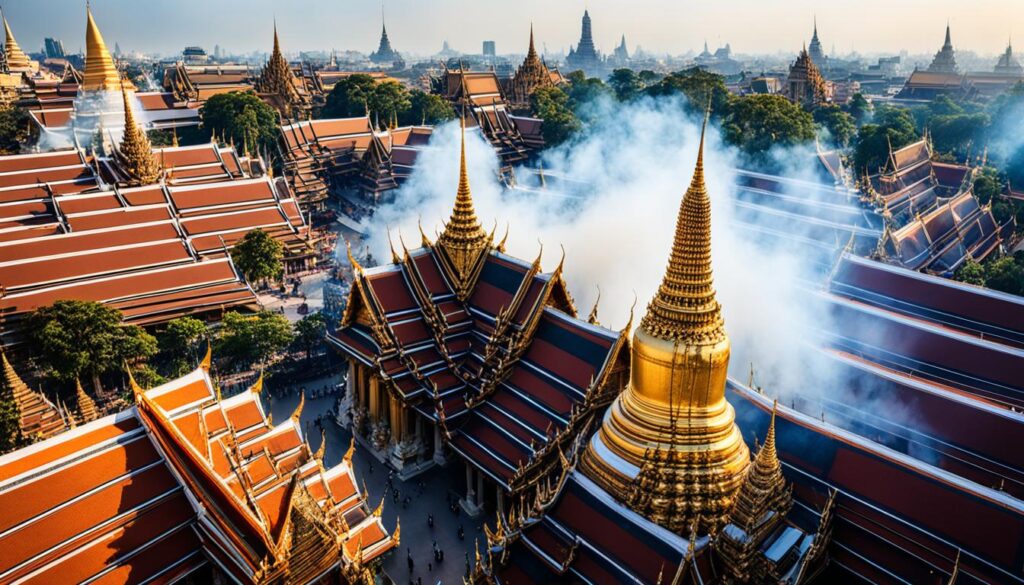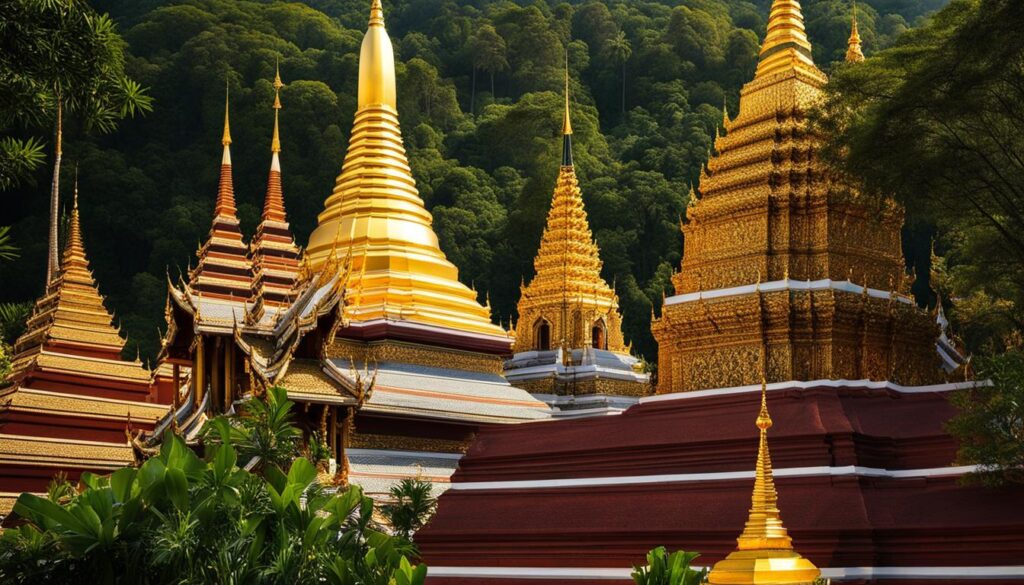
Exploring Thailand Temples: A Sacred Journey
Thailand, with its vibrant culture and rich heritage, is renowned for its magnificent temples that offer a sacred journey to visitors. 🏯✨
Imagine standing in awe of the architectural masterpieces that showcase intricate designs, exquisite craftsmanship, and centuries of spiritual legacy in every corner.
Join us on a virtual tour of Thailand’s most famous temples, as we delve into their fascinating history, stunning architecture, and the enlightening experiences they offer. Discover the best temples to visit in Thailand, uncover interesting temple facts, and embark on an unforgettable journey through the heart and soul of this enchanting country. 🌍
So, sit back, relax, and let us take you on a captivating exploration of the top temples in Thailand.
The Majesty of Wat Arun
Wat Arun, also known as the Temple of Dawn, is a mesmerizing sight rising on the Thonburi bank of the Chao Phraya River. Its iconic Khmer-style spire illuminated by the morning sunlight creates a breathtaking view.
The temple’s intricate architecture and porcelain encrusted tower make it a must-visit destination for those seeking to explore Thailand’s temple heritage. The central prang, or tower, reaches a height of 79 meters and is adorned with beautiful carvings, colorful porcelain, and fragments of seashells. This unique blend of architectural styles and delicate craftsmanship showcases the rich cultural traditions and artistic excellence of Thailand.
Legend has it that Wat Arun was named after the Hindu god Aruna, who is often personified as the radiations of the rising sun. The temple’s spire, with its intricate details and delicate sculptures, is the main highlight. Visitors can climb the steep steps of the central prang, which represent the journey to reach enlightenment, and be rewarded with panoramic views of the Chao Phraya River and the surrounding areas.
“Wat Arun stands as a testament to Thailand’s rich history and cultural heritage. Its majestic presence and ornate details leave a lasting impression on all who visit.”
Wat Arun also plays an important role in the religious and cultural life of the Thai people. It is a place of worship and hosts various ceremonies and festivals throughout the year, including the Chao Phraya River Festival and the King’s birthday celebrations.
Visitors can explore the temple grounds, stroll along the riverside promenade, and marvel at the intricate designs and symbolic motifs that adorn the temple’s architecture. The tranquil atmosphere and stunning views make Wat Arun a perfect place for reflection and contemplation.
Whether you are fascinated by Thailand’s temple architecture or simply seeking a serene and awe-inspiring experience, a visit to Wat Arun is sure to leave you captivated and inspired.
The Cultural Treasure of Wat Phra Kaew
Nested within the Grand Palace, Wat Phra Kaew is a treasure trove of Thai culture. Its main attraction is the Emerald Buddha, the most revered Buddha image in Thailand. With its historical significance and spiritual aura, Wat Phra Kaew offers visitors a unique opportunity to witness the rich cultural heritage of the country.

Located in the heart of Bangkok, the capital city of Thailand, Wat Phra Kaew is one of the most famous temples in the country. The temple’s intricate design and exquisite artwork make it a masterpiece of Thai craftsmanship. From ornate golden decorations to vibrant murals depicting scenes from Buddhist mythology, every detail of Wat Phra Kaew showcases the rich cultural traditions and artistic talents of Thailand.
The Emerald Buddha, enshrined within the temple, is a highly revered symbol of Thai religious beliefs. Carved from a single block of jade, this small but meticulously crafted statue is believed to bring prosperity and good fortune to those who pay their respects. Visitors to Wat Phra Kaew can witness the devoted worship of the Emerald Buddha by locals and tourists alike, experiencing the profound spirituality that permeates the temple grounds.
A Glimpse into Thailand’s Cultural Heritage
“Wat Phra Kaew is not just a temple; it is a living testament to Thailand’s rich cultural heritage. The intricate architecture, elaborate decorations, and spiritual significance of the Emerald Buddha make this temple a must-visit for anyone seeking to immerse themselves in Thai culture.”
Exploring Wat Phra Kaew is like stepping back in time, as the temple has witnessed centuries of Thai history and served as the spiritual center of the kingdom. The temple complex itself is home to various structures and sacred halls, each playing a unique role in Thai Buddhism and offering a glimpse into the country’s religious practices.
| Key Features of Wat Phra Kaew | Description |
|---|---|
| Main Ubosot | The main ordination hall where important religious ceremonies take place. |
| Phra Wihan Yot | A pavilion housing a collection of exquisite murals depicting the life of the Buddha. |
| Phra Mondop | A library holding sacred Buddhist scriptures. |
| Model of Angkor Wat | A scale model of Cambodia’s iconic Angkor Wat temple complex, showcasing the cultural connections between Thailand and its neighboring countries. |
Visitors to Wat Phra Kaew are advised to dress modestly as a sign of respect for the temple’s sacredness. Modest attire includes clothing that covers the shoulders and knees. Additionally, it is customary to remove shoes before entering the temple buildings.
Exploring Wat Phra Kaew is a journey into the heart of Thai culture and spirituality. As one of the most famous temples in Thailand, it offers a unique opportunity to immerse oneself in the country’s rich traditions, witness stunning architectural marvels, and experience the profound reverence for the Emerald Buddha.
The Serene Retreat of Wat Phra That Doi Suthep
Perched high in the mountains above Chiang Mai, Wat Phra That Doi Suthep is a majestic temple that offers a serene retreat for visitors seeking spiritual solace. With its gleaming gold chedi and intricate decorations, this temple stands as a symbol of faith and devotion.
As you make your way up the Naga staircase, adorned with mythical serpent statues, you’ll be enveloped in a sense of tranquility. The panoramic view of Chiang Mai from the temple grounds is a testament to the temple’s elevated position and its role as a spiritual guardian of the city.
Exploring the temple complex, you’ll find beautiful murals depicting the life of the Buddha and intricate carvings of mythical creatures. The main attraction of Wat Phra That Doi Suthep is the sacred relic, said to contain a fragment of the Buddha’s bone. This relic is enshrined within the golden chedi, adding to the temple’s significance and spiritual aura.
The peaceful ambiance of Wat Phra That Doi Suthep creates the perfect environment for quiet contemplation and meditation. Visitors can participate in Buddhist rituals, such as offering flowers and incense, or simply sit in silence, absorbing the serenity of the surroundings.

“Visiting Wat Phra That Doi Suthep felt like stepping into a sacred realm. The tranquility and spirituality of the temple were truly captivating.”
Temple Highlights:
- Stunning views of Chiang Mai from the temple grounds
- Golden chedi containing a sacred relic of the Buddha
- Intricate decorations and carvings
- Peaceful ambiance for meditation and reflection
How to Visit Wat Phra That Doi Suthep:
Wat Phra That Doi Suthep is located approximately 15 kilometers from Chiang Mai city center. Visitors can reach the temple by climbing the Naga staircase or taking a cable car ride for those who prefer a less strenuous ascent. Guided tours and transportation services are available for a convenient and insightful visit to this spiritual retreat.
| Opening Hours | Entrance Fee | Location |
|---|---|---|
| 6:00 AM – 6:00 PM | 30 THB (for foreigners) | Doi Suthep, Mueang Chiang Mai District, Chiang Mai, Thailand |
The Artistic Wonder of Wat Rong Khun
Wat Rong Khun, also known as the White Temple, is an artistic masterpiece designed by Chalermchai Kositpipat. Its unconventional design and depiction of Buddhist teachings and modern ideologies make it a must-visit for art enthusiasts. This contemporary temple stands out with its surreal appearance, resembling a scene from a dream or fantasy.
As you enter the temple grounds, you are greeted by an imposing blend of white and mirrored glass, symbolizing purity and wisdom. The intricate details of the architecture, meticulously crafted with ornate carvings and delicate motifs, showcase the creativity and skill of the artist.
The interior of Wat Rong Khun is just as remarkable as its exterior. The walls are adorned with vibrant murals depicting a blend of traditional Buddhist teachings and contemporary themes. The ceiling features intricate paintings of stars, symbolizing enlightenment and the spiritual journey.
This unconventional temple is a breath of fresh air in the world of temple architecture. It challenges the traditional norms while paying homage to the spiritual heritage of Buddhism. The White Temple invites visitors to explore the intersection of art, spirituality, and modernity.
Key Features of Wat Rong Khun:
- Unconventional design
- Depiction of Buddhist teachings and modern ideologies
- Imposing blend of white and mirrored glass
- Intricate carvings and delicate motifs
- Vibrant murals blending tradition and contemporary themes
- Stunning ceiling paintings of stars
Wat Rong Khun is a testament to the boundless creativity of Chalermchai Kositpipat. It is a thought-provoking and visually stunning contemporary temple that must be experienced to appreciate its true beauty and significance.
Visiting Wat Rong Khun is not only an opportunity to marvel at architectural brilliance but also to delve into the depths of artistic expression and spiritual contemplation. It is a journey that stimulates the senses and ignites the imagination.
Continue your sacred exploration of Thailand’s temples by discovering the historical ruins of Wat Phra Phai Luang in Section 6.
The Historical Ruins of Wat Phra Phai Luang
Situated in the Sukhothai Historical Park, Wat Phra Phai Luang stands as a testament to the rich history of Thailand and the significance of Sukhothai as a former capital. This weather-beaten structure, with its ancient ruins, invites visitors to journey back in time and experience the allure of the ancient kingdom of Sukhothai.
Wat Phra Phai Luang, also known as the “Temple of the Great Lotus”, showcases the architectural styles of the Sukhothai period. Its crumbling walls and moss-covered structures evoke a sense of mystery, offering a glimpse into a bygone era. Exploring these historic temple ruins is like delving into the pages of a history book, allowing travelers to uncover stories of kings, conquerors, and the rise and fall of civilizations.
Within the peaceful surroundings of Sukhothai Historical Park, visitors can stroll among the ancient temples, statues, and moats, immersing themselves in the ambiance of the past. As you wander through the remnants of Wat Phra Phai Luang, you can contemplate the architectural ingenuity of the Sukhothai period and the spiritual significance of these sacred grounds.
While time has taken its toll on Wat Phra Phai Luang, the lasting majesty of these ruins serves as a reminder of the enduring legacy of the ancient kingdom of Sukhothai. Exploring this historical site is a must for history enthusiasts, cultural explorers, and anyone seeking to connect with the roots of Thailand’s rich heritage.
The Significance of Sukhothai as a Former Capital
Sukhothai, meaning “Dawn of Happiness,” was the capital of the Kingdom of Sukhothai from the 13th to the 15th century. It was during this period that the Thai people established their independent identity and laid the foundation for the nation as we know it today. The kingdom’s influence spread throughout Southeast Asia, and its cultural, artistic, and architectural achievements continue to shape the region’s heritage.
| Reasons for Visiting Wat Phra Phai Luang | Benefits of Exploring the Ruins |
|---|---|
| To witness the historical significance of Sukhothai as a former capital | Gain insight into the rise and fall of a significant ancient kingdom |
| To explore the architectural styles of the Sukhothai period | Appreciate the artistry and craftsmanship of the time |
| To experience the spiritual ambiance of the ancient ruins | Connect with the sacred and reflect on the passage of time |
| To delve into the stories and legends of Sukhothai | Uncover the tales of kings, conquerors, and ancient civilizations |
The Grandeur of Wat Chaiwatthanaram
Located on the banks of the Chao Phraya River, Wat Chaiwatthanaram showcases the grandeur of the Ayutthaya Kingdom. This magnificent temple is a testament to the rich historical and cultural heritage of Thailand. With its Khmer-style architecture and breathtaking views, Wat Chaiwatthanaram ranks among the top temples in Thailand.
Wat Chaiwatthanaram was built in the 17th century by King Prasat Thong to honor his mother. The temple’s design and layout reflect the influence of the Khmer Empire, showcasing intricate carvings, majestic spires, and ornate decorations.
During its peak, Wat Chaiwatthanaram served as a place of worship, a meditation retreat, and a venue for royal ceremonies. Today, visitors flock to this temple to experience its serene ambience, observe the well-preserved ruins, and immerse themselves in the rich history of the Ayutthaya Kingdom.
“The beauty of Wat Chaiwatthanaram is truly captivating. The ancient ruins, the intricate details, and the picturesque setting make it a must-visit for anyone exploring Thailand’s temple heritage.”
– Local guide
The temple’s location by the Chao Phraya River offers a stunning backdrop, especially during sunset when the warm hues bathe the temple grounds in a magical glow. As you wander through the temple complex, you’ll encounter numerous Buddha statues and intricately carved scenes from Buddhist mythology.
| Key Highlights of Wat Chaiwatthanaram |
|---|
| Khmer-style architecture |
| Well-preserved historical ruins |
| Scenic location by the Chao Phraya River |
| Breathtaking views during sunset |
| Intricate carvings and sculptures |
The History of Wat Chaiwatthanaram
Wat Chaiwatthanaram was commissioned by King Prasat Thong as a tribute to his mother. The temple was constructed on the site where his mother’s cremation took place. The name “Wat Chaiwatthanaram” translates to “the temple of long-lasting glory.”
Over the centuries, the temple suffered damage and neglect, particularly during the Burmese invasion in the 18th century. However, extensive restoration efforts have preserved its grandeur, allowing visitors to appreciate its historical significance and architectural beauty.
Exploring Wat Chaiwatthanaram is like stepping back in time, providing a glimpse into Thailand’s glorious past. The temple stands as a reminder of the Ayutthaya Kingdom’s power, influence, and cultural legacy.
Discovering the Spiritual Heart of Thailand
Thailand’s temples are not just architectural wonders; they are gateways to exploring the spiritual heart of the country. Each temple carries centuries-old stories, spiritual beliefs, and cultural richness. By visiting these temples, travelers can immerse themselves in the sacred ambiance, experience the serenity, and witness the timeless traditions of Thailand.
Embarking on a spiritual journey through the land of Thailand’s temples requires respect for local customs and a deep appreciation for the spiritual aura that permeates these sacred spaces. The Thai temple culture is deeply rooted in Buddhism, with monks and devotees engaging in rituals, meditation, and acts of devotion. The tranquility one finds in these temples creates an opportunity for introspection, self-discovery, and a connection to something greater than oneself.
Exploring the spiritual heart of Thailand through its temples is a profound experience that allows travelers to not only witness the beauty of the architecture but also delve into the essence of Thai culture and spirituality. It is a chance to gain insight into the values, beliefs, and traditions that have shaped the country. Whether it’s the majestic Wat Arun, the cultural treasure of Wat Phra Kaew, or the serene retreat of Wat Phra That Doi Suthep, each temple offers a unique journey into the depths of spirituality and self-discovery.
Source Links
- https://simify.com/blogs/travel/famous-thailand-temples
- https://dreamworldtours.in/8-mystical-thai-temples-you-must-visit/
- https://thailandeventguide.com/temples-in-thailand/

Leave a Reply